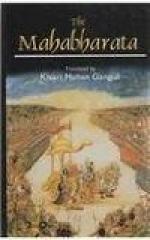endued with the three attributes of Sattwa, Rajas,
and Tamas. From that element in it which represented
the principle of Rajas, sprang all mobile creatures
endued with the principle of Pravritti or action.[390]
From the element of Tamas in it, sprang all immobile
creatures. The principle of Sattwa, however,
which dwelt in that seed, entered both kinds of existences.
That attribute of Sattwa is of the nature of Tejas
or Light (being identical with Buddhi or the Understanding).
It is eternal and of it is unending Space.[391] In
all creatures the attribute of Sattwa is present and
is identical with that light which shows what is right
and what is wrong. When the seed of Brahman was
thus poured as a libation on that sacrificial fire,
there sprang from it, O mighty one, three beings into
existence. They were three male persons, endued
with bodies that partook of the characters of the
circumstances from which they respectively sprang.
One arose first from the flames of the fire (called
Bhrig) and hence he came to be called by the name
of Bhrigu. A second came from the burning charcoals
(called Angara) and hence he came to be called by the
name of Angiras. The third sprang from a heap
of extinguished charcoals and he came to be called
by the name of Kavi. It has been already said
that the first came out with flames emanating from
his body and hence he was called Bhrigu. From
the rays of the sacrificial fire sprang another called
Marichi. From Marichi (afterwards) sprang Kasyapa.
It has been already said that from the (burning) charcoals
sprang Angiras. The (diminutive) Rishis called
Valakhilyas sprang from the blades of Kusa grass spread
out in that sacrifice. From the same blades of
Kula grass, O thou of great puissance, sprang Atri.
From the ashes of the fire sprang all those that are
numbered among the regenerate Rishis, viz., the
Vaikhanasas, endued with penances and devoted to Vedic
lore and all excellent accomplishments. From
the eyes of Agni sprang the twin Aswins endued with
great beauty of person. At last, from his ears,
sprang all the Prajapatis. The Rishis sprang
from the pores of Agni’s body. From his
sweat sprang Chhandas, and from his strength sprang
Mind. For this reason, Agni has been said to
be all the deities in his individual self, by Rishis
endued with Vedic lore, guided by the authority of
the Vedas. The pieces of wood that keep alive
the flames of Agni are regarded as the Months.
The Juices that the fuel yields constitute the Fortnights.
The liver of Agni is called the Day and Night, and
his fierce light is called the Muhurtas. The
blood of Agni is regarded as the source of the Rudras.
From his blood sprang also the gold-complexioned deities
called the Maitradevatas. From his smoke sprang
the Vasus. From his flames sprang the Rudras
as also the (twelve) Adityas of great effulgence.
The Planets and Constellations and other stars that
have been set in their respective orbits in the firmament,
are regarded as the (burning) charcoals of Agni.
The first Creator of the universe declared Agni to
be Supreme Brahma and Eternal, and the giver of all
wishes. This is verily a mystery.




